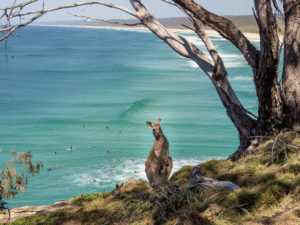Australia, a land of stunning landscapes and natural marvels, is home to a coastline adorned with dramatic cliffs, pristine beaches, and awe-inspiring rock formations. Among these, the Twelve Apostles emerge as a testament to the might of nature and time, mesmerizing visitors with their grandeur. Situated along the iconic Great Ocean Road in Victoria, these limestone stacks rise majestically from the Southern Ocean, forming one of Australia’s most recognizable landmarks.
The Formation of Giants: A Geological Tale
These impressive structures were not formed overnight. Their creation spans millions of years, showcasing the relentless forces of erosion. The Twelve Apostles originated as part of the mainland cliffs, consisting of soft limestone from the Miocene epoch.
Over time, the powerful Southern Ocean, with its unyielding waves and fierce winds, steadily eroded the cliffs. The softer limestone gradually gave way, forming caves, arches, and eventually isolating the towering stacks we admire today.
Key stages in the formation of the Twelve Apostles:
- Cliff Formation: Coastal cliffs formed from ancient limestone deposits.
- Cave Formation: Persistent wave action eroded weaker sections of the cliffs, creating caves.
- Arch Formation: Continued erosion expanded the caves, resulting in the formation of arches.
- Stack Formation: The arches eventually collapsed, leaving behind isolated limestone stacks – the Apostles.
- Ongoing Erosion: Erosion continues to reshape the stacks and the coastline, with some stacks already having collapsed, underscoring their impermanence.
More Than Just Eight: The Story Behind the Name
Despite their name, only eight apostles stand today. Erosion, the very force that created them, continues to reshape them. Over the years, several stacks have succumbed to the relentless waves, collapsing into the ocean. The most recent collapse occurred in 2005, leaving eight guardians of the coastline.
The name “Twelve Apostles” is somewhat misleading and is believed to have been adopted for its appeal to tourists. Originally called the “Sow and Pigs” (with Muttonbird Island as the ‘Sow’ and the smaller stacks as the ‘Pigs’), the name was changed in the 1920s to the more evocative “Twelve Apostles” – even though there were never twelve stacks recorded in history.
Experiencing the Majesty: Visiting the Twelve Apostles
A visit to the Twelve Apostles offers an unforgettable experience. The dramatic coastline, punctuated by these towering limestone formations, is a sight that inspires awe. Here are some ways to immerse yourself in their beauty:
Viewing Platforms and Walks
The Twelve Apostles Visitor Centre provides stunning viewing platforms with panoramic vistas of the apostles and the surrounding coastline. Several walking trails cater to various abilities, allowing visitors to explore the area and uncover hidden treasures along the coast.
Helicopter Tours
For a unique perspective, consider a helicopter tour. Flying above the coastline reveals the full scale and grandeur of the apostles and the rugged beauty of the landscape. It’s an experience that leaves a lasting impression.
Sunset and Sunrise Viewing
Watching the apostles at sunrise or sunset is truly magical. As the sun casts vibrant hues across the sky, the limestone stacks glow warmly, creating a breathtaking display of light and shadow. The serene atmosphere enhances the beauty of this natural wonder.
Beyond the Apostles: Exploring the Great Ocean Road
While the Twelve Apostles are a highlight, the Great Ocean Road offers countless other attractions and activities:
- Loch Ard Gorge: Uncover the tragic story of the Loch Ard shipwreck and explore the dramatic gorge shaped by ocean forces.
- London Bridge: Admire this natural archway (now transformed into two stacks) and learn about its fascinating history.
- The Grotto: Marvel at this unique sinkhole formation, showcasing the power of erosion.
- Great Otway National Park: Venture inland to discover lush rainforests, cascading waterfalls, and diverse wildlife.
- Coastal Towns: Visit charming towns like Port Campbell and Apollo Bay, savoring local cuisine and soaking in the relaxed atmosphere.
Planning Your Trip: Tips and Considerations
To get the most out of your visit to the Twelve Apostles and the Great Ocean Road, keep these tips in mind:
- Best time to visit: While the area is stunning year-round, spring and autumn offer pleasant weather and fewer crowds.
- Accommodation: Choose from a variety of options, including budget-friendly hostels and luxurious hotels.
- Transportation: Driving along the Great Ocean Road is the best way to explore at your own pace, though tours from Melbourne are also available.
- Weather conditions: Be prepared for unpredictable weather. Pack layers and check the forecast before heading out.
- Respect the environment: Preserve this natural wonder by staying on designated paths, disposing of waste responsibly, and respecting the local wildlife.
A Timeless Wonder: Preserving the Legacy
The Twelve Apostles are a testament to the power of nature and the passage of time. These awe-inspiring limestone stacks, shaped by the relentless forces of the Southern Ocean, continue to draw visitors from across the globe. As we marvel at their beauty, it’s crucial to recognize their fragility and contribute to their preservation. By doing so, we ensure that future generations can witness the splendor of these coastal giants. A journey to the Twelve Apostles is more than a sightseeing trip – it’s an encounter with the raw power and beauty of nature, an experience that leaves an indelible mark on the soul.



